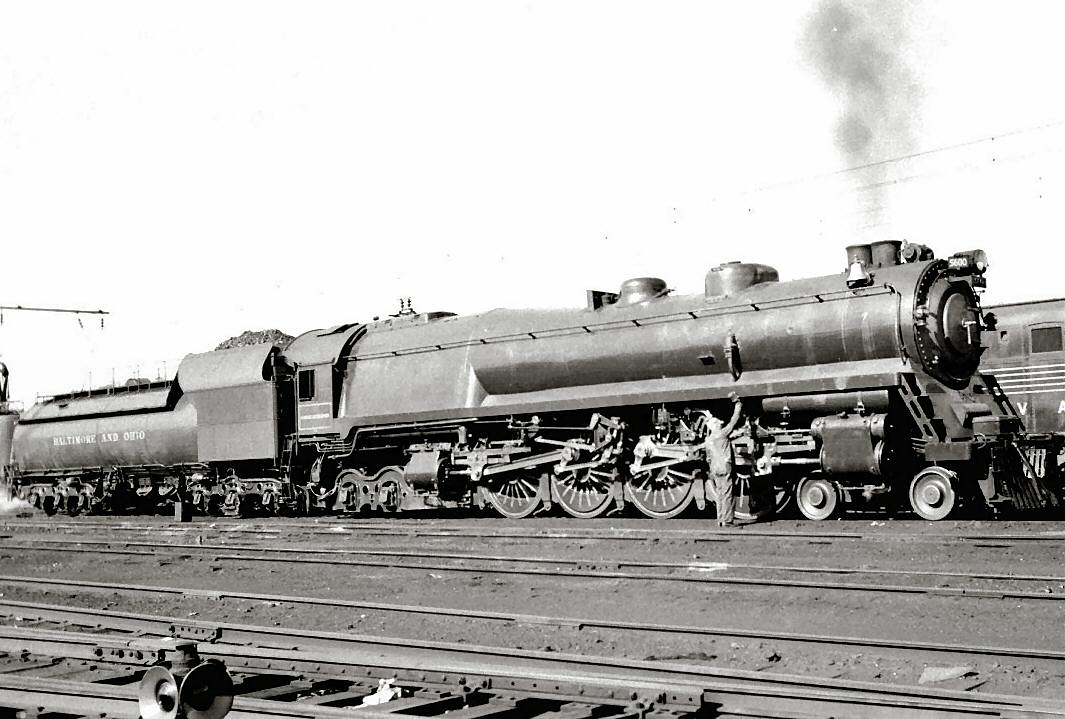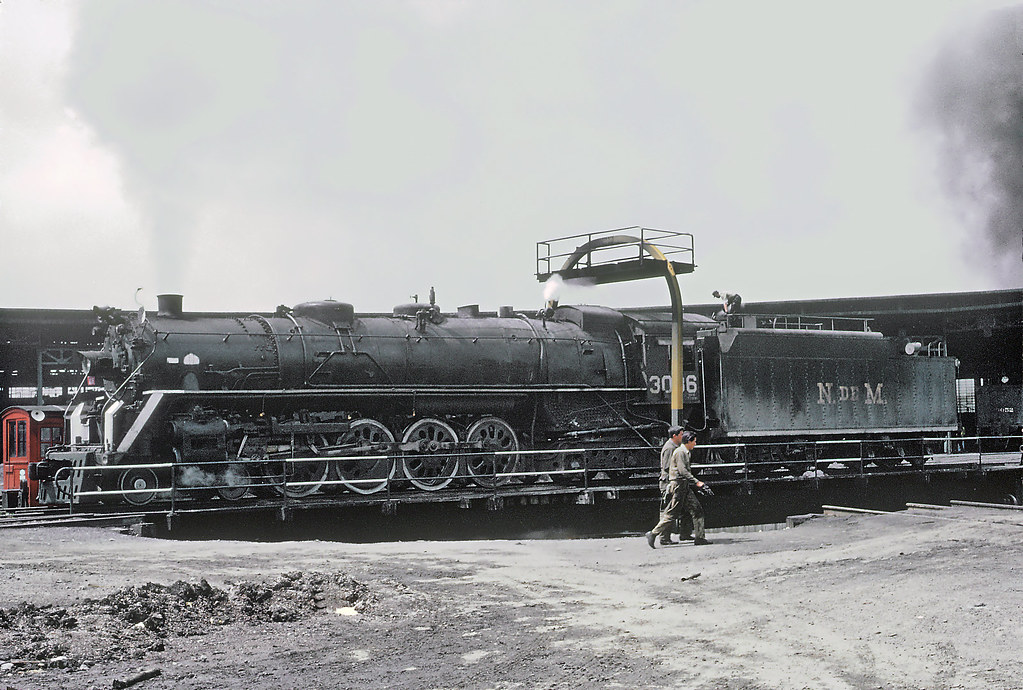In reply to NickD :
Wow, that's kinda crazy.
Not quite as widespread as poppet valves, the Duplex Drive concept also had its time in the sun, with two railroads building them and a couple others looking at them.
The best known and most numerous are PRR's various engines, the S1 6-4-4-6 (1939), the T1 (1941 and 1945), the Q1 (1942) and the Q2s (1944-1945). The S1 and Q1 were disasters, the T1s are the most famous and most populous, and the Q2s were the most successful.
The first appearance of a Duplex Drive locomotive (two sets of relatively small engines on a rigid frame) was in 1937, with Baltimore & Ohio #5600, the George H. Emerson. Designed by Emerson, who was the superintendent of motive power for the B&O from 1927-1942, the #5600, class N-1, was supposed to be his crowning achievement. It used a 4-4-4-4 wheel arrangement, with the rear set of cylinders mounted in the back alongside the firebox to shorten up the wheelbase. It also had a 350psi boiler, 76" drivers, and a water-tube boiler where water-filled piping circulated vertically through the firebox. Emerson was a big proponent of the water-tube boiler, having applied it to a 2-8-2, five 4-6-4s, a 4-6-2, and a 2-6-6-2. But while water-tube boilers work great in naval or industrial applications, they weren't well-suited to railroad usage due to the varying steam demands. And the rear-mounted cylinders were also prone to trouble from the heat of the firebox, sand and dirt kicked up by the drive wheels, and cinders from the firebox. There were also complaints about the locomotive being very slippery to operate, a common issue with Duplex designs. The uniquely European-looking locomotive wowed attendees at the 1939 World's Fair, but spent most of the '40s parked on the sidelines and was scrapped in 1950.

Around 1937, Baldwin Locomotive Works began looking into the Duplex Drive theory. This seems to be as a result of the issues that the 1800-series 4-8-4s that they built for the Atlantic Coast Line. Troubles with balancing resulted in the 1800s physically bouncing the drivers off of the rails at high speeds, and it took a fair amount of tinkering with different driver designs and counterweights and crossheads to fix it. I don't know if the George H Emerson would influence Baldwin's thinking, or vice versa, but Baldwin theorized that four sets of short connecting rods would be easier to balance than 2 long connecting rods. Hoping to woo back ACL, Baldwin pitched them a 4-4-4-4 Duplex that was streamlined by Otto Kuhler, with a vestibule cab and centipede tender. By that point, ACL had heart eyes for the EMD E3s and turned down Baldwin's proposal.

Baldwin remained convinced of the benefits of the Duplex Drive and they were the one that convinced the PRR to try the Duplex design on their locomotives in the late '30s and '40s. PRR actually lent a T1 to both the N&W and the C&O and both of those railroads tested the T1 and found it much ado about nothing. If it had faired better, perhaps we would have seen #611 built as a 4-4-4-4. But while those two railroads were unimpressed with the T1, archrival New York Central was eyeballing it jealously. While it never went further than a blueprint, New York Central considered a 4-4-4-4, class C-1a, which would have been mechanically identicall to an S-1 Niagara, except for the Duplex drive. On the New York Central's famously flat terrain, perhaps the C-1a would have been a success. But Robert R Young's presidency of the line put an end to it.

Perhaps the strangest was in July of 1945, the Lehigh Valley had blueprints drawn up for a 4-4-6-4 freight Duplex. The specs are remarkably close to a PRR Q2, which would make sense since the PRR owned the LV. What makes less sense is that the LV was a very curvy railroad, and this proposed engine wouldn't have been able to run on a lot of the line, as well as having issues fitting on the turntables that they had. It was pretty much dead on arrival, since Cecil Majors took over not long after. By 1948, all LV passenger service was dieselized. By 1951, all steam power was gone.

On the subject of never-was: in the 1930s, Alco secured the licensing to construct Beyer-Garrat locomotives for the North American market. These are the locomotives typically seen in Africa, India, and Australia where there is an engine at each end, with a water cistern over one and a coal or oil bunker over the other, and the cab, boiler, and firebox suspended over the middle. The Beyer-Garrat designs advantages were it was equally capable running either direction, it offered excellent tractive effort while having fairly low axle ratings and much better flexibility than an articulated, and the boiler and firebox could be as large as loading gauges allowed, since you didn't have a running gear under it.

Alco ultimately built exactly zero for the US market. According to David Page Morgan, the GM&N was definitely interested since they had heavy grades on lines that had to climb in and out of the Mississippi River valley that had light (60-75lb) rail and some tight curves. They ultimately decided against it. Canadian Pacific also looked at Garratts, partially because the president of CP was friend's with the head of Beyer, but also declined. But if the design had gained traction (no pun intender) it would have been interesting to see what transpired. Logging 2-6-0+0-6-2s in the Pacific Northwest? Narrow-gauge 2-8-2+2-8-2s climbing the Rockies on the D&RGW? Long-haul 4-6-2+2-6-4 express locomotives rounding Horseshoe Curve? Instead of Big Boys, 4-8-4+4-8-4, or even 2-10-2+2-10-2s, on Sherman Hill?
The less restricted loading gauges of the US, the fact that by the time Alco acquired the rights to the Garratt, the Mallet design was well-entrenched on US lines, a certain "not invented here" xenophobia, and the arrival of early diesels on the scene all doomed the Garratt from ever gaining footing in North America.
In reply to NickD :
I don't remember ever seeing pics of the Garratt before. What an odd looking loco.
In reply to Pete Gossett (Forum Supporter) :
They aren't terribly common. There were only about 1700 built total, in all sorts of configurations. And they were all mostly used by British colonies. They ranged from a tiny little 0-4-0+0-4-0 up to a big 4-8-2+2-8-4. Alco was supposedly planning a 2-6-6-2+2-6-6-2 "Super Garratt" but never sold any.
Another weird one was the Mason Bogie. They look similar to the Forney tank engines, like the Maine 2-footers, but the pilot truck drive wheels and cylinders an articulated assembly and could swivel under the boiler as one piece, and the trailing truck under the tank swiveled separately. They were believed to be suited to the uneven track and sharp curves of narrow gauge railroads. Approximately 146 Mason Bogies were produced by William Mason's firm between 1871 and 1890 when the firm built its last locomotive, of which 88 or so were narrow gauge units, the rest being gauge. The major operators were the Boston, Revere Beach & Lynn suburban line, the Denver, South Park & Pacific narrow gauge in Colorado, and the New York & Manhattan Beach suburban line. The DSP&P had the largest, with several 2-6-6s and 2-8-6s. Steam leakage from the jointed pipes to the engine assembly was a huge issue, as was surprisingly poor tracking on curvy tracks that wore the rail and the wheels flanges excessively. Today there is one Mason Bogie in existence: the Torch Lake, an 1873-built 0-6-4 that is in operation at The Henry Ford. There was one of the DSP&P Mason Bogies at the University of Iowa that was donated in 1905, but it was sadly scrapped in 1942 as part of the WWII scrap drives. And there is an old myth about another DSP&P Mason Bogie trapped in the caved-in Alpine Tunnel on the old South Park Line, although that seems to be just that, a myth.


The Torch Lake in operation at Greenfield Village. The Torch Lake also is the oldest regularly operating steam locomotive in the US
The Calumet & Hecla Mining Company, in addition to the Torch Lake, had 4 other Mason Bogies. Like the Denver, South Park & Pacific engine at Iowa University, they were all cut up during a WWII scrap drive in 1942. A pretty sad loss from a unique railroad, especially considering that the WWII scrap drives are now believed to have been mostly civilian morale exercises with little actual impact on the war. Most of the scrapped locomotives were stored in the company's main locomotive facilities while Torch Lake was stashed away in its own little single track shed at the far end of the line somewhere around 1933 and thankfully didn't meet the same fate.

As the last fires were dropped from the grates in the US, many railfans turned north to Canada to find steam locomotives operational in general revenue. But this was only a temporary reprieve, as Canadian steam was also in it's twilight, only a year or two behind the US. And so, those not happy with occasional excursions like the Reading Rambles or far-flung shortlines and logging railroads, looked south to Mexico. And there on the Ferrocarilles Nacionales de Mexico (Mexican National Railroad) they found a wealth of steam engines still in general revenue.
There was the unfamiliar, like unusually tall-drivered Baldwin-built 4-8-0s being used in passenger service.

Or outside-framed narrow gauge 2-8-0s with comically large headlights plying the old Ferrocarilles Interoceanico network out of Mexico City.

Or the handsome, 1946 Alco-built pocket 4-8-4s that were even called Niágara by the locals. Light by US standards, they were also oddly modern and antiquated at the same time, with stuff like cast engine beds, Nathan non-lifting injectors, roller bearing drivers, thermic syphons, Type E superheater, lateral motion device on lead drivers, but then single-stage air compressors, dome-mounted throttles, no mechanical lubricators, and no feedwater heater.

There was also the familiar, with a variety of USRA power, like Pacifics, Light Mikados and 2-6-6-2s, still in use, with touches favored by N de M engineers, like silver-painted smokeboxes, bells hung out over the front end, large headlights and custom number plates



And finally, there were the old friends found living out a second life. Flagler-era Florida East Coast 4-8-2s sent south of the border when the Florida real estate bubble and the Great Depression threatened to shake the road apart (Supposedly photographer Don Wood went down to Mexico in the '60s in hopes of repatriating one back north of the border but was unsuccessful). Those odd, and rarely seen, Norfolk Southern 2-8-4s, distinguishable by their unusual tenders. Old Chicago, Rock Island & Pacific 2-8-0s poking along tracks overrun with weeds.


I really like the narrow gauge 2-8-0s, largely because of that headlight that would make even an L&N engine blush


While a lot of the older power, the 4-8-0s and ex-FEC Mountains and USRA engines, were retired in 1964, the QR-1 Niagaras lasted until 1968 in general revenue. Where else could you see 4-8-4s in regular operation alongside SD40s and GP38s?

You'll need to log in to post.